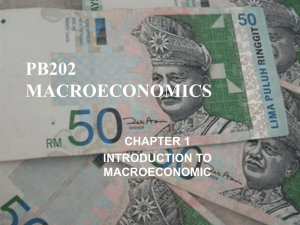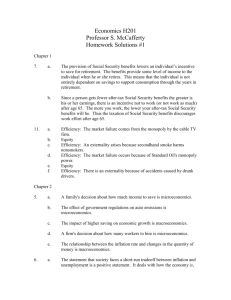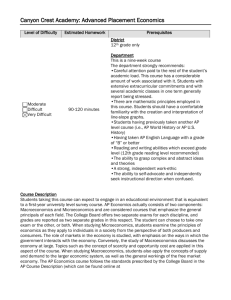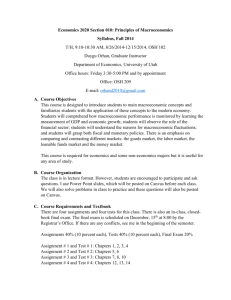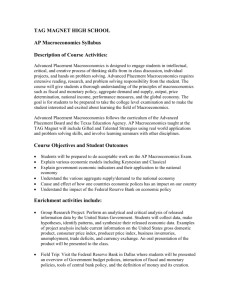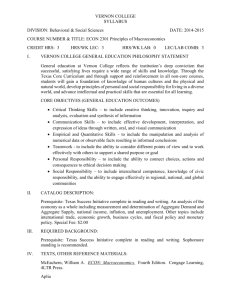AP Macroeconomics Course Code: 40544 Course Level: Advanced
advertisement
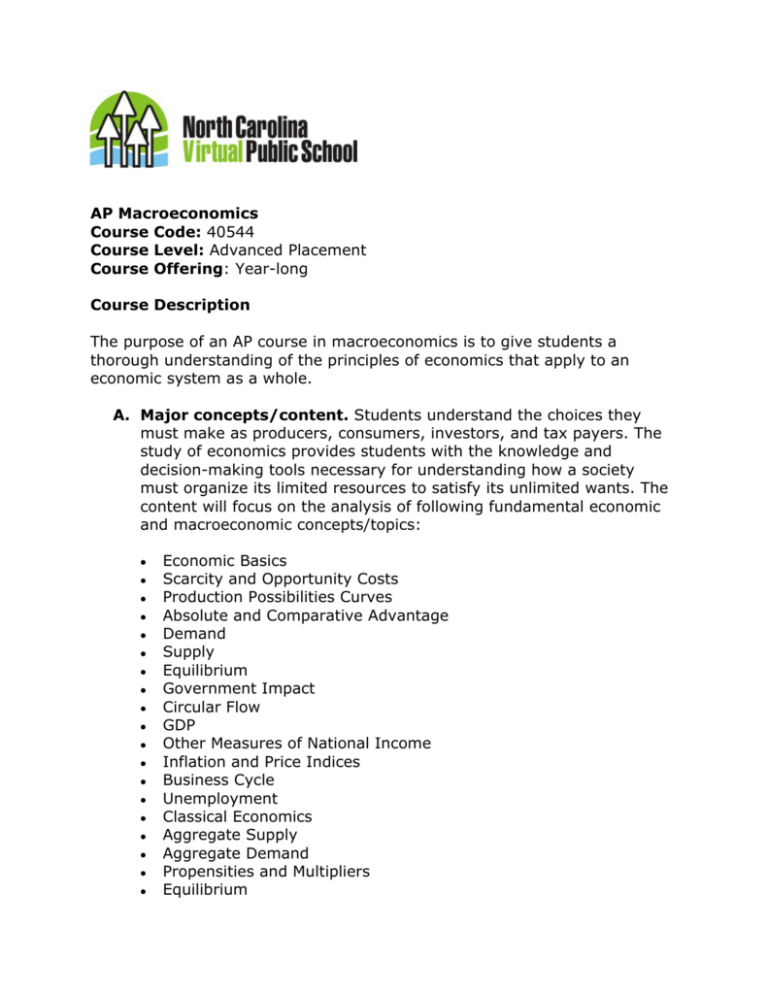
AP Macroeconomics Course Code: 40544 Course Level: Advanced Placement Course Offering: Year-long Course Description The purpose of an AP course in macroeconomics is to give students a thorough understanding of the principles of economics that apply to an economic system as a whole. A. Major concepts/content. Students understand the choices they must make as producers, consumers, investors, and tax payers. The study of economics provides students with the knowledge and decision-making tools necessary for understanding how a society must organize its limited resources to satisfy its unlimited wants. The content will focus on the analysis of following fundamental economic and macroeconomic concepts/topics: • • • • • • • • • • • • • • • • • • • Economic Basics Scarcity and Opportunity Costs Production Possibilities Curves Absolute and Comparative Advantage Demand Supply Equilibrium Government Impact Circular Flow GDP Other Measures of National Income Inflation and Price Indices Business Cycle Unemployment Classical Economics Aggregate Supply Aggregate Demand Propensities and Multipliers Equilibrium • • • • • • • • • • • • • • • • • • • • • • • • • Economic Growth The AE Model Understanding the AD/AS Model Comparative Advantage and International Trade Balance of Payments Exchange Rates Graphing Foreign Exchange International Value of Currency Trade Barriers Understanding International Trade and Finance The Money Supply Loanable Funds Market Equation of Exchange Money Creation Fiscal Policy Automatic Stabilizers Debt vs. Deficit Interview Fiscal Policy and Interest Rates The Federal Reserve System Monetary Policy Interest Rates and the Impact on Financial Capital Phillips Curve Modern Theories Understanding Policies Guided Review B. Special note. See Advanced Placement syllabus for specific content requirements. C. Course Requirements. After successfully completing this course, the student will: 1. Understand the fundamental concepts of the American mixed economic system. 2. Analyze the various aspects of the gross national product and its value as an economic barometer. 3. Examine aggregate supply and determine how much of our resources should be devoted to increasing productive capacity as opposed to how much should be spent on current consumption. 4. Compare the components of aggregate demand, including total consumer spending, business investments and government spending. 5. Evaluate remedies to deal with the problems of unemployment including frictional, structural and cyclical unemployment. 6. Differentiate between inflation and deflation; more specifically, demand-pull inflation and cost-push inflation. 7. Understand the role of the federal reserve system as it manages the nation's monetary policy. 8. Distinguish between the President and Congress as each seeks to establish the nation's fiscal policy. 9. Apply the basic methodology associated with the study of macroeconomics. 10. Apply research, study, critical-thinking and decision-making skills and demonstrate the use of new and emerging technology in problem solving. D. Course Assessment: Assessments can be in the form of self-checks, practice lessons, multiple choice questions, writing assignments, freeresponse essays, oral assessments, and discussions. Textbooks: Provided by FLVS AP Microeconomics Course Code: 40554 Course Level: Advanced Placement Course Offering: Year-long Course Description The purpose of an AP course in microeconomics is to give students a thorough understanding of the principles of economics that apply to the functions of individual decision makers, both consumers and producers, within the economic system. It places primary emphasis on the nature and functions of product markets, and includes the study of factor markets and of the role of government in promoting greater efficiency and equity in the economy. A. Major concepts/content. In order for students to acquire the knowledge and decision-making tools necessary for understanding how society must organize its limited resources to satisfy its unlimited wants, students learn factors that influence the economic system. The content will focus on the analysis of the following fundamental economic and macroeconomic concepts/topics: • • • • • • • • • • • • • • • • • Economic Basics Production Possibilities Frontier Types of Economic Systems Economic Reasoning Activity Absolute vs. Comparative Advantage Understanding Economic Basics Equilibrium Shifts in Supply and Demand Models of Consumer Demand Excise Tax Production Costs Production Curve Graph Perfect Competition Short and Long Run Consumer and Producer Surplus Monopolies Monopolistic Competition • • • • • • • • • • • • • Oligopoly Market Structure Circular Flow Marginal Productivity Theory Determinants of Demand and Resources Wages Outsourcing Private vs. Public Goods Externalities Economic Situations: Environment and Government Introduction to Taxes Income Distribution Guided Review B. Special note. See Advanced Placement syllabus for specific content requirements. C. Course Requirements. After successfully completing this course, the student will: 1. Understand the fundamental concepts of the American mixed economic system. 2. Analyze the circular flow of resources, goods, services and money in markets. 3. Compare the relationship between supply and demand in the competitive market. 4. Evaluate market structures and analyze structures that are highly competitive as compared to those that contain a single seller. 5. Examine the various aspects of the functional distribution of income and the personal distribution of income. 6. Analyze why markets fail and public policy responses to those failures. 7. Analyze the impact of the role of government in the American economy from historical and contemporary perspectives. 8. Apply the basic methodology associated with the study of microeconomics with attention to critical thinking skills and development of economic essay. 9. Apply research, study, critical-thinking, and decision-making skills and demonstrate the use of new and emerging technology in problem solving. D. Course Assessment: Assessments can be in the form of self-checks, practice lessons, multiple choice questions, writing assignments, freeresponse essays, oral assessments, and discussions Textbooks: Provided by FLVS
